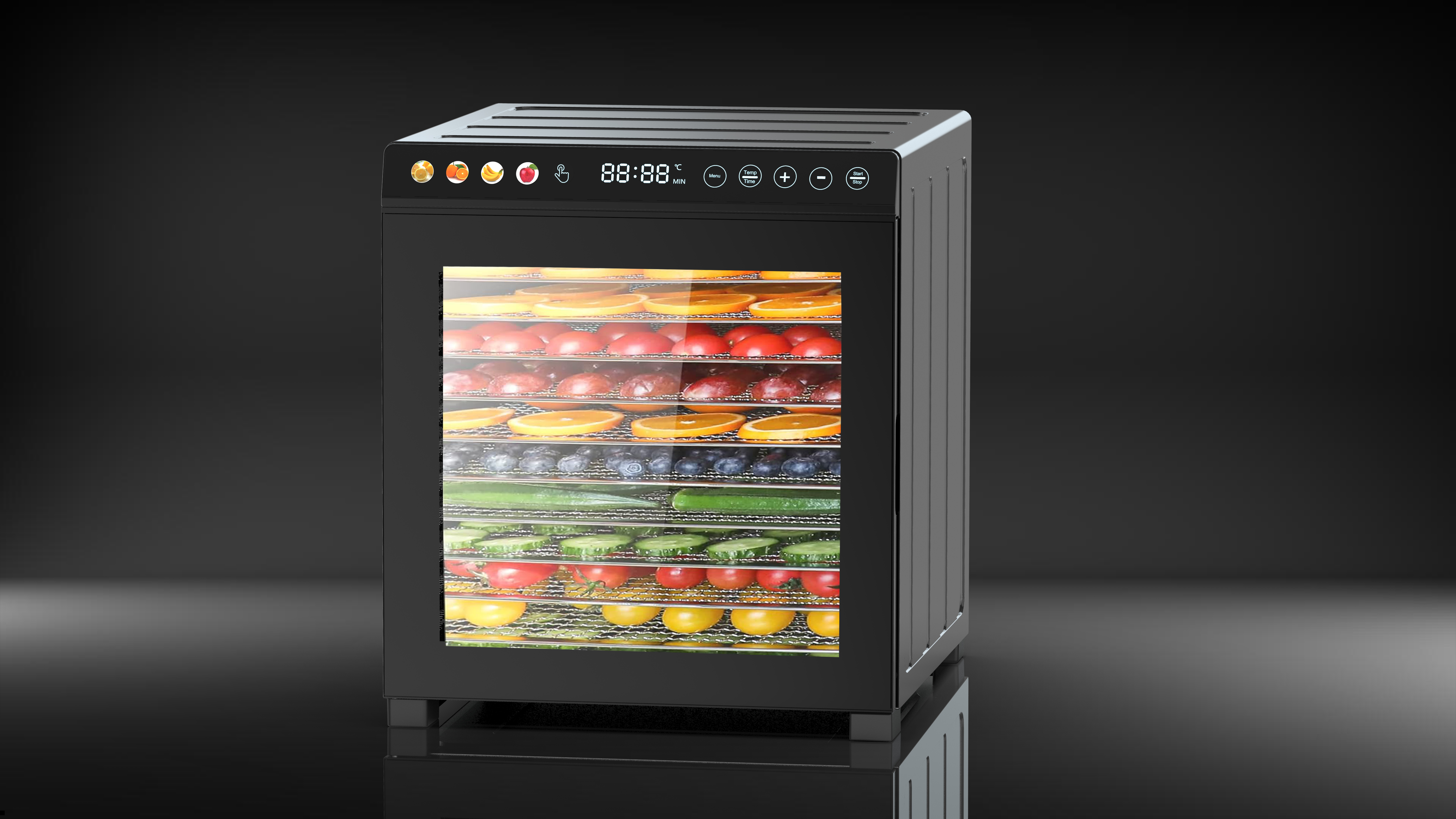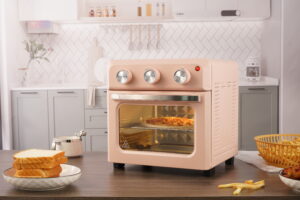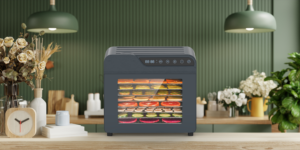As the Sales Manager at Foshan Linden Intelligent Appliances Co., Ltd., I’ve spent years working with kitchen appliance buyers, procurement officers, and distributors who demand top-quality products. One of our flagship offerings, the food dehydrator, is a perfect example of how thoughtful design and engineering deliver consistent, high-quality results. In this article, I’ll break down the key structural elements of a food dehydrator that ensure reliable performance, exceptional drying consistency, and durability. Whether you’re a distributor or a supermarket purchase manager, understanding these components will help you choose the best food dehydrator for your market.
What Makes a Food Dehydrator Effective?
A food dehydrator’s success lies in its ability to remove moisture from food evenly while preserving flavor, nutrients, and texture. At Foshan Linden, we design our dehydrators with precision to meet the high standards of our global clients in North America, Europe, Russia, and the Middle East. The structural components I’ll discuss below work together to ensure consistent drying results, energy efficiency, and user satisfaction.
Let’s dive into the critical elements that make our food dehydrators stand out.
The Heating Element: The Heart of Consistent Drying
Why the Heating Element Matters
The heating element is the powerhouse of any food dehydrator. It generates the controlled heat needed to evaporate moisture from fruits, vegetables, herbs, or meats. A high-quality heating element ensures even heat distribution, which is critical for uniform drying across all trays.
Our Approach at Foshan Linden
At Foshan Linden, we use advanced ceramic or stainless steel heating elements in our food dehydrators. These materials are durable and provide stable heat output. Unlike cheaper alternatives, our heating elements maintain precise temperatures, preventing hot spots that can lead to uneven drying.
For example, our dehydrators feature adjustable thermostats, allowing users to set temperatures between 35°C and 70°C, depending on the food type. This flexibility ensures delicate items like herbs dry gently, while tougher items like meat jerky dehydrate efficiently.
Pro Tip for Buyers
When sourcing dehydrators, look for models with thermostatically controlled heating elements. According to Energy Star guidelines, energy-efficient heating systems reduce power consumption by up to 20%, which is a selling point for eco-conscious consumers.
Air Circulation System: Ensuring Uniform Airflow
The Role of Fans in Dehydration
A robust air circulation system is critical for consistent drying. Without proper airflow, moisture can linger on some trays, leading to uneven results or spoilage. Fans in a food dehydrator distribute warm air evenly across all trays, ensuring every piece of food dries at the same rate.
Our Design Philosophy
In our 12L, 16L, and 30L food dehydrators, we incorporate high-efficiency axial fans positioned strategically to optimize airflow. Our horizontal airflow design, as opposed to vertical systems, ensures that air moves evenly from side to side. This reduces the need to rotate trays during the drying process—a common pain point in lower-quality models.
Why It Matters for Your Business
For distributors and importers, offering a dehydrator with superior airflow translates to fewer customer complaints about inconsistent results. Our horizontal airflow system, inspired by research from The University of Wisconsin’s Food Science Department, minimizes drying time by up to 15% compared to vertical airflow models.
Tray Design: Maximizing Space and Efficiency
The Importance of Tray Configuration
The trays in a food dehydrator are where the magic happens. Their design directly impacts how much food you can process and how evenly it dries. Poorly designed trays can lead to sticking, uneven drying, or wasted space.
Our Customizable Tray Solutions
At Foshan Linden, we offer BPA-free, food-grade stainless steel or plastic trays with fine mesh inserts. These trays are designed to maximize surface area while allowing optimal air circulation. Our dehydrators come with stackable trays, giving buyers the flexibility to adjust capacity based on their needs.
For example, our 30L model includes up to 10 trays, perfect for bulk drying. The trays are also dishwasher-safe, making cleanup a breeze—a feature that resonates with busy households and commercial kitchens alike.
SEO-Friendly Tip
When marketing food dehydrators, highlight keywords like “BPA-free trays” and “stackable drying racks”. These terms align with consumer searches for safe and efficient kitchen appliances, boosting your product’s visibility on Google.
Temperature Control System: Precision for Perfect Results
Why Temperature Control Is Non-Negotiable
Precise temperature control is essential for preserving the nutritional value and flavor of dehydrated foods. Too much heat can degrade nutrients, while too little can prolong drying times, risking spoilage.
Our Advanced Thermostat Technology
Our food dehydrators feature digital temperature controls with precise increments. This allows users to tailor settings to specific foods, from low-heat drying for herbs to higher temperatures for meats. We also include built-in timers, so users can set drying cycles and walk away without worrying about over-drying.
Industry Insights
According to a report by Grand View Research, consumers increasingly demand appliances with customizable settings. Our dehydrators meet this trend head-on, offering settings that cater to both novice users and professional chefs.
Housing and Insulation: Durability Meets Efficiency
The Role of the Dehydrator’s Body
The housing of a food dehydrator does more than hold components together. It protects internal systems, ensures safety, and contributes to energy efficiency. Poor insulation can lead to heat loss, increasing energy costs and drying times.
Our Commitment to Quality
At Foshan Linden, we use double-walled stainless steel or high-grade plastic housing with thermal insulation. This design minimizes heat loss, keeping energy consumption low. Our dehydrators are also built to withstand heavy use, making them ideal for both home and commercial applications.
Why It Matters for Buyers
For procurement officers sourcing for supermarkets or distributors, durability is key. Our dehydrators undergo rigorous quality inspections to meet certifications like CE, UL, and RoHS, ensuring compliance with international standards for safety and performance.
User-Friendly Interface: Simplifying the Drying Process
Why Ease of Use Matters
A food dehydrator should be intuitive, even for first-time users. A complicated interface can deter customers, leading to returns or negative reviews.
Our Approach to Design
Our dehydrators feature digital LED displays and simple button controls. Users can easily adjust temperature, set timers, and monitor progress. We also include detailed manuals and recipe guides to help users get started, which is a big plus for distributors targeting retail markets.
Pro Tip for Importers
When selecting dehydrators, prioritize models with multilingual manuals and clear interfaces. This caters to diverse markets in North America, Europe, and the Middle East, where language accessibility is a growing demand.
Safety Features: Protecting Users and Products
Why Safety Is a Priority
Safety is non-negotiable in kitchen appliances. Overheating or electrical faults can pose risks to users and damage the dehydrator’s reputation.
Our Built-In Safety Mechanisms
Our dehydrators come equipped with automatic shut-off systems and overheat protection. These features prevent damage to the unit and ensure user safety. We also use flame-retardant materials in our housing, meeting stringent safety standards.
Industry Standards
According to UL Standards, appliances with built-in safety features reduce liability risks for manufacturers and distributors. This is a critical consideration for buyers sourcing for large brands or supermarkets.
Customizable Features: Meeting Diverse Market Needs
Why Customization Matters
Every market has unique preferences. Some customers prioritize sleek, modern designs, while others prefer warm color tones or specific accessories.
Our Flexible Solutions
At Foshan Linden, we offer OEM and ODM services, allowing buyers to customize dehydrators to their specifications. From color options to tray configurations, we work closely with clients to create products that align with their brand identity. Our ability to offer warm-toned finishes, for example, caters to markets that favor inviting aesthetics.
SEO Opportunity
Incorporate keywords like “customizable food dehydrator” and “OEM kitchen appliances” in your marketing. These terms resonate with procurement officers searching for tailored solutions.
Logistics and Certifications: Streamlining the Supply Chain
Why Certifications Are Critical
For global markets, certifications like CE, UL, and RoHS are essential. They ensure compliance with safety and environmental standards, simplifying customs processes.
Our Commitment to Compliance
All our food dehydrators undergo rigorous third-party quality inspections. We provide full documentation to support smooth logistics, from production to delivery. This is especially important for buyers in North America and Europe, where regulatory compliance is a top priority.
Pro Tip for Distributors
When sourcing, prioritize suppliers who offer transparent certification processes. This reduces delays and ensures your products meet market-specific regulations.
Why Choose Foshan Linden for Your Food Dehydrator Needs?
At Foshan Linden Intelligent Appliances Co., Ltd., we pride ourselves on delivering high-quality, customizable food dehydrators that meet the needs of diverse markets. Our three production lines in China enable us to scale efficiently, whether you’re placing large-scale orders or seeking tailored OEM solutions. With a focus on consistent drying results, energy efficiency, and user-friendly design, our dehydrators are built to exceed expectations.
Ready to elevate your product lineup? Visit our website at www.lindensmart.com or meet us at upcoming trade shows to explore our range of food dehydrators, air fryer ovens, and air fryers. Let’s work together to bring top-tier kitchen appliances to your customers.
Meta Title: Key Structural Elements of a Food Dehydrator for Consistent Results
Meta Description: Discover the essential components of a food dehydrator that ensure consistent drying results. Learn how Foshan Linden’s designs deliver quality and efficiency.
Permalink: /key-structural-elements-food-dehydrator-consistent-results




